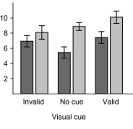Resumen
The vigilance decrement phenomenon has been traditionally studied by simple and monotonous behavioral tasks. Nowadays, however, there is considerable interest in measuring vigilance with more complex tasks, including independent measures of other attentional functions. In the present study, we provide evidence supporting the suitability of the Attentional Networks Test for Interactions and Vigilance – executive and arousal components (ANTI-Vea) as an appropriate method to simultaneously assess multiple attentional and vigilance components. Vigilance was examined as two dissociated components: executive vigilance –as the detection of infrequent signals– and arousal vigilance –as the sustenance of a fast reaction to stimuli without response selection–. Importantly, the executive vigilance decrement was analyzed with a novel methodological approach to particularly determine whether the sensitivity loss effect is influenced by a floor level on the false alarms. As expected, the ANTI-Vea proved to be a task suitable to assess: (a) the main effects and interactions of phasic alertness, orienting, and executive control; (b) the executive vigilance decrement as a progressive change in the response bias; and (c) the arousal vigilance decrement as a progressive slowness and variability in reaction time. We discuss some critical theoretical and empirical implications of measuring vigilance components with the ANTI-Vea task. We expect the present study to provide a suitable method to analyze the vigilance decrement phenomenon when measuring multiple attentional and vigilance functions.
